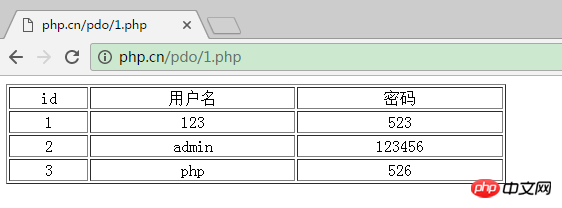
Detailed explanation of the fetch() method for obtaining result sets in PDO
When we introduced how PHP operates MYSQL, we also introduced several methods for obtaining result sets. For those who are not familiar with the records, you can go to our special topic PHP Operation MySQL to review. There are also several methods to obtain the result set in PDO. We will introduce these methods one by one!
In the previous article "Three ways to execute SQL statements in PDO", we introduced three ways for PDO to execute SQL statements, so in this article we will introduce PDO acquisition The fetch() method, one of several methods of the result set!
The fetch() method obtains the next row of data in the result set. The specific syntax format of this function is as follows:
mixed PDOStatement::fetch ([ int $fetch_style [, int $cursor_orientation = PDO::FETCH_ORI_NEXT [, int $cursor_offset = 0 ]]] )
Parameter fetch_style: controls the return method of the result set. The optional values are as follows: :
| Value | says Ming |
| PDO::FETCH_ASSOC | associative array form . |
| PDO::FETCH_NUM | Number index array form. |
| PDO::FETCH_BOTH | Both are available in array form, which is the default. |
| PDO::FETCH_OBJ | In the form of an object, it is similar to the previous mysql_fetch_object() function. |
| PDO::FETCH_BOUND | Returns the result in the form of a Boolean value, and assigns the obtained column value to the variable specified in the bindParam() method. |
| PDO::FETCH_LAZY | Returns the results in 3 forms: associative array, numeric index array and object. |
Parameter cursor_orientation: A scrolling cursor of the PDOStatement object that can obtain a specified row.
Parameter cursor_offset: The offset of the cursor.
The following example uses the fetch() method to obtain the next row of data in the result set, and then uses the while statement to complete the loop output of the data in the database. The steps are as follows:
First create a php file and use PDO Connect to the MySQL database, then define the SELECT query statement, use the prepare() and execute() methods to perform the query operation, then return the next row of data in the result set through the fetch() method, and set the result set to be returned in the form of an associative array, and finally use the while The statement completes the loop output of the data. The specific code is as follows:
prepare($query);//准备查询语句 $res->execute(); //执行查询语句,并返回结果集 ?>
| id | 用户名 | 密码 |
The final output is as follows:

About the fetch() method of obtaining the result set in PDO, we That’s it for the introduction. You can try it in your local area and contact us to consolidate what you have learned. In the next article, we will continue to introduce to you the method of obtaining the result set in PDO. For details, please read "PDO Detailed explanation of the fetchAll() method to obtain the result set》!
The above is the detailed content of Detailed explanation of the fetch() method for obtaining result sets in PDO. For more information, please follow other related articles on the PHP Chinese website!
 How to connect php to mssql database
How to connect php to mssql database How to solve error code 8024401C
How to solve error code 8024401C What are the common management systems?
What are the common management systems? What platform is Kuai Tuan Tuan?
What platform is Kuai Tuan Tuan? Windows photos cannot be displayed
Windows photos cannot be displayed The latest ranking of the top ten exchanges in the currency circle
The latest ranking of the top ten exchanges in the currency circle Usage of instr function in oracle
Usage of instr function in oracle What are the applications of the Internet of Things?
What are the applications of the Internet of Things?



